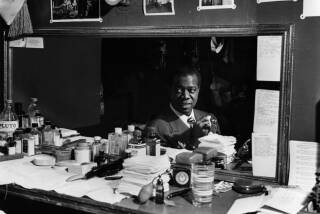JAZZ REVIEW : Cherry Spreads Himself Thin
- Share via
Was it a case of the emperor’s new clothes or a brief look inside the essence of the creative process? Don Cherry’s solo performance at McCabe’s Friday night appeared to promote the latter. But there were many moments when one expected an unconvinced observer to stand up and shout, “Nothing’s happening here!”
Best known, perhaps, for his role in the ‘60s as Ornette Coleman’s pocket trumpet-playing sidekick, Cherry has traveled an iconoclastic path in the intervening years. Bits and pieces of Indian, African and South American music have drifted through his recordings and concerts, and he has become one of the significant early players in the gathering synthesis of world music.
Cherry’s solo program made sputtering efforts to draw from all those experiences. At various times, he sat on the floor cross-legged to play a set of wooden flutes to the accompaniment of a pre-set rhythm track, and strummed rhythms on a stringed instrument he described as an “African guitar.”
Occasionally, he moved to the piano for spirited, if not especially articulate readings of pieces by Coleman and Thelonious Monk. And when all else failed, he simply shuffled around the stage scatting bebop lines and tossing in little homilies of philosophical advice.
Had the performer been anyone other than Cherry--let’s say one who lacked the trumpeter’s on-the-cutting-edge image and reputation--the performance would surely have seemed embarrassingly inadequate. Cherry’s keyboard playing (on piano and synthesizer) was typical of the way most horn men approach those instruments--with interesting harmonies, but little facility. His work on wooden flutes and “African guitar, as well as his rudimentary demonstration of Indian rhythm talas, revealed enthusiasm, but no particular skill.
One kept hoping, nonetheless, that the evening’s individual events, no matter how small they appeared, would somehow coalesce into a larger, more persuasive picture. But it never happened.
Cherry is an undeniably appealing personality whose creative intentions are admirable. But the execution of his art--in this display, at least--was woefully lacking in substance.
More to Read
The biggest entertainment stories
Get our big stories about Hollywood, film, television, music, arts, culture and more right in your inbox as soon as they publish.
You may occasionally receive promotional content from the Los Angeles Times.









